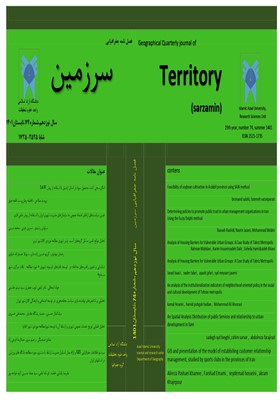شناسایی و تدوین راهبردهای مداخله در توسعه بافتهای فرسوده شهری « مورد مطالعه : بافت مرکزی شهر سنندج»
محورهای موضوعی : جغرافیای سیاسیجواد اسحاقی 1 * , نادر تابعی 2 , ایوب جعفری 3 , سید میثم جاسمی 4
1 - دکتری جغرافیای سیاسی،پژوهشگر دانشگاه عالی دفاع ملی ، تهران ، ایران
2 - دانشجوی دکتری جغرافیا و برنامه ریزی شهری،دانشگاه تهران ، تهران ،ایران
3 - دانشجوی دکتری اقلیمشناسی،دانشگاه تهران، تهران ، ایران
4 - کارشناسی ارشد اقلیمشناسی سینوپتیک، دانشگاه تهران ، تهران ، ایران
کلید واژه: توسعه, بافت فرسوده, مدل SWOT, GIS و سنندج,
چکیده مقاله :
تبعات حاصل از تشدید مسائل اقتصادی، اجتماعی، سیاسی، مدیریتی و زیست محیطی ناشی از رشد شهر و زوال بافت های بارزش قدیمی بخش مرکزی، سیاست های شهری را به سمت نوسازی و بهسازی بافت های فرسوده شهری یا به عبارتی بهتر رشد شهر از درون سوق داد. هدف این مقاله شناسایی بافت های فرسوده شهری و تدوین راهبردهای مداخله در توسعه بافت فرسوده بخش مرکزی شهری سنندج است. روش تحقیق توصیفی تحلیل است. در این پژوهش از نرمافزار GIS بهمنظور شناسایی فرسودگی بخش مرکزی شهر با توجه به سه شاخص (ریزدانگی، نفوذناپذیری و پایداری)، استفادهشده است. در ادامه برای تعیین راهبرد در سه معیار ویژگیهای عملکردی، ارتباطی و زیستمحیطی از مدل SWOT استفادهشده است. نتایج حاصل از تحلیل دادههای GIS نشان می دهد که بافت فرسوده محدوده موردمطالعه بهجز در قسمت های مرکزی بافت، آنهم به دلیل وجود کاربریهای نوساز و تجمیع شده و همجواری بافت های این بخش با مسیرهای اصلی ارتباطی شهر، در وضعیت مطلوبی قرار ندارد. همچنین نتایج تحلیل مدل SWOT نشان داد که برای تقویت ویژگی عملکردی، ارتباطی و زیستمحیطی بافت، به ترتیب استراتژیهای محافظه کارانه، تهاجمی و محافظهکارانه به کار گرفته شود.
The main challenges facing the urban planners of this city are the formation of slums due to the lack of suitable formal space and the ability of vulnerable groups of the city, followed by the formation of slums and poor durability, unsuitable texture, poor urban services and building materials, vulnerability. The housing units of these social classes are exposed to natural hazards such as earthquakes and the spread of various social harms among the low-income groups due to the prevailing geographical space. Solving these challenges will not be possible except by thinking of macro measures and adopting new approaches. Instability in the housing sector of Tabriz is related to the large area of worn-out structures and informal settlements. Accordingly, the purpose of this study is to identify and analyze the barriers to housing for vulnerable groups. The method of this research is applied in terms of purpose and descriptive and survey type. To select the indicators affecting housing and prioritize these indicators in vulnerable groups, 20 experts are used by Delphi method to test the questionnaire randomly for weighting. Some of the required information has been collected from the Statistics Center. Findings show that social and economic indicators have a significant impact on housing for low-income groups. The results show that regions ten and three have the highest rank in the amount of vulnerable housing in the metropolis of Tabriz.
_||_

